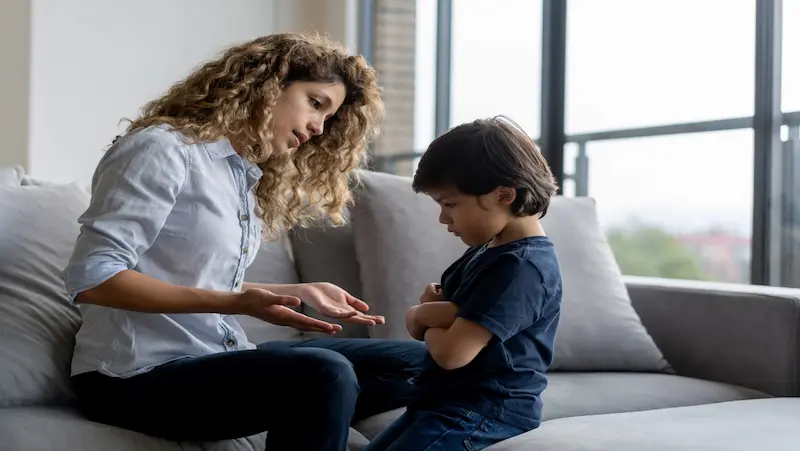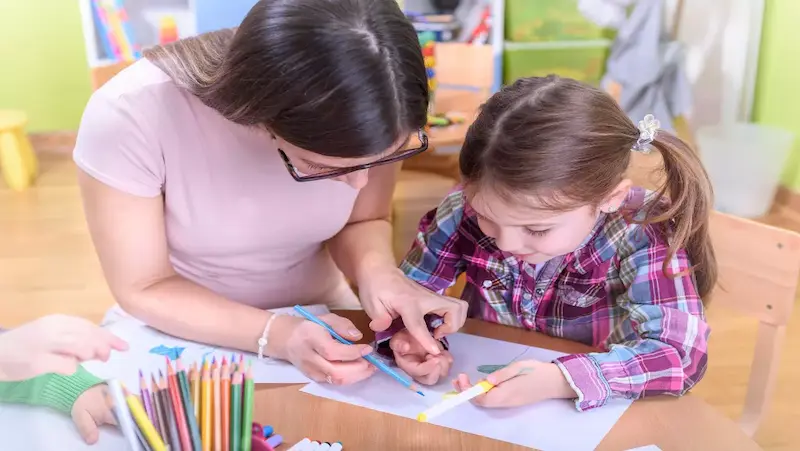In the intricate dance of raising kids, there’s a subtle but profound force that shapes their world—positive parenting. It’s not just a set of rules or a strict routine; it’s a guiding light that influences how children see themselves and the world around them. Picture this: a child’s first steps into the world, a world filled with endless possibilities and challenges. It’s in these moments that positive parenting takes center stage, offering a compass to navigate the complexities of growing up. It’s more than just a buzzword; it’s a philosophy that cultivates a nurturing environment, fostering not just well-behaved kids but resilient, empathetic, and confident individuals. So, let’s delve into the significance of positive parenting and discover how this approach can shape the future of our little ones.
Table of contents
Understanding Behavior Problems
Have you ever found yourself scratching your head, wondering why your child, friend, or even yourself is exhibiting certain behavior problems? Trust us, you’re not alone. Behavior problems can be as puzzling as a Rubik’s Cube, but fear not – let’s unravel the mystery together.

Different Types of Behavior Problems
1. Aggression
Picture this: little Timmy, fists clenched, ready to tackle the world with his fiery spirit. Aggression is like that untamed dragon in all of us, sometimes rearing its head when we least expect it. It’s not just about physical acts but can include verbal outbursts too.
2. Defiance
Ever met someone who just won’t follow the rules? Defiance is that rebellious streak we all have – a refusal to play by the book. From not doing homework to ignoring a direct order, defiance can be as frustrating as a door that won’t open when you need it to.
3. Anxiety
Meet Sarah, the worrywart of the group. Anxiety is like a shadow that looms large, causing restlessness, unease, and even panic. It’s the feeling you get before a big test, only dialed up to 11 and lingering longer than you’d like.
4. Attention Issues
Daydreaming, fidgeting, or constantly seeking the limelight – we’ve all been there. Attention issues are like mischievous butterflies, fluttering around, making it challenging to focus on the task at hand.
Common Causes of Behavior Problems
1. Biological Factors
Our bodies are complex machines, and sometimes, they don’t run on smooth autopilot. Biological factors, like genetics or imbalances in brain chemicals, can throw a wrench into the works, influencing how we behave.
2. Environmental Factors
Imagine growing a delicate flower in the wrong soil – it won’t flourish. Similarly, our environment plays a massive role in shaping our behavior. Chaotic homes, stressful workplaces, or lack of supportive networks can plant the seeds of behavior problems.
3. Emotional Factors
Emotions are the spice of life, but too much spice can be overwhelming. Unresolved emotions, traumatic experiences, or a lack of emotional regulation skills can turn our emotional rollercoaster into a wild ride, leading to behavior issues.
So, there you have it – a peek into the diverse world of behavior problems. It’s like having a personal GPS to navigate the twists and turns of human behavior. Remember, understanding the why is the first step to finding the how – how to cope, how to support, and how to help those around us.
Signs and Symptoms

Recognizing Behavior Problems
Life is a rollercoaster, and so are our emotions. We’ve all had those moments when things just feel a bit off, right? But how do you know when those off days turn into something more?
- Sudden Changes: If someone you know starts acting out of character, it could be a red flag. Maybe your usually chatty friend becomes unusually quiet, or your typically calm pet suddenly turns into a whirlwind of energy.
- Isolation: We all need our alone time, but if someone you care about is withdrawing from social activities or isolating themselves, it might be time to check-in.
- Drastic Mood Swings: We’re all entitled to a mood swing or two, but when the ups and downs start resembling a rollercoaster, it’s worth paying attention.
- Difficulty Concentrating: Whether it’s at school, work, or even during a casual conversation, struggling to focus might indicate something deeper.
When to Seek Professional Help
Recognizing behavior changes is the first step, but knowing when to seek help is just as crucial. We’re all in this together, and sometimes, a little extra support can make a world of difference.
- Consistency in Behavior Changes: If the shifts in behavior become a regular occurrence, it’s a good idea to consult with a professional. Consistency might be a sign that something more significant is at play.
- Impact on Daily Life: When these changes start affecting daily activities, like work, school, or relationships, it’s time to consider professional help. Life is challenging, but it’s not meant to be a constant struggle.
- Expressed Concern: If the person experiencing the behavior changes expresses worry or discomfort themselves, that’s a clear signal to seek support. Sometimes, we all need a helping hand to guide us through tough times.
Remember, there’s no shame in reaching out for help. Just like we visit a doctor for physical health, seeking professional guidance for mental and emotional well-being is a proactive step toward a healthier, happier life.
Building a Strong Parent-Child Relationship
Just like any melody, it requires the right notes and harmonies to create something beautiful. Let’s explore the key elements that compose this symphony and make it resonate with love and understanding.

Communication: The Heartbeat of Connection
Imagine communication as the heartbeat of your relationship with your child. It’s not just about words; it’s about the rhythm, the pauses, and the shared beats. Talk to your child openly, honestly, and with genuine interest. Listen not just to respond but to understand. Share your thoughts and feelings, creating a safe space where they feel heard and valued. Like any good conversation, it’s a two-way street.
Empathy: Walking in Their Shoes
Empathy is the magical ability to walk in someone else’s shoes, and in the parent-child dance, it’s a move that should be practiced often. Understand your child’s perspective, acknowledge their feelings, and validate their experiences. When they stumble, offer a helping hand instead of judgment. By showing empathy, you’re not just teaching them understanding; you’re building a bridge that connects your hearts.
Trust: The Glue that Binds
Trust is the glue that binds a parent and child together. It’s built on a foundation of consistency, reliability, and honesty. Keep your promises, be a steady presence in their lives, and let them know they can rely on you. Trust is fragile; handle it with care. When trust is the backbone of your relationship, it creates an environment where openness and security flourish.
Quality Time: More Than Clock Watching
In the hustle and bustle of daily life, quality time often takes a back seat to deadlines and chores. However, in the parent-child relationship, quality time is the secret sauce. It’s not about the quantity; it’s about the richness of the moments you share. Whether it’s a simple game, a heartfelt conversation, or just being present, these moments weave a tapestry of connection that lasts a lifetime.
Positive Discipline Techniques

Setting Clear Boundaries
Think of boundaries as the magical fence around your child’s wonderland. Setting clear boundaries is like putting up signposts that guide them through the enchanted forest of life. Kids thrive on knowing what’s expected of them. It’s like handing them a treasure map with the X clearly marked.
So, when you say, “No snacks before dinner,” or “Lights out at 8,” you’re not being the evil queen – you’re the wise wizard, teaching them the ways of the kingdom.
Consistency
Imagine a world where the sun rises in the west one day and the east the next. Chaos, right? Kids crave consistency like flowers crave sunlight. If you let them stay up late on weekdays and enforce bedtime like a drill sergeant on weekends, confusion reigns.
Consistency is your magic wand. If you say it, mean it. If a rule exists, uphold it. Your child is learning the ways of the world from you. Be the unwavering lighthouse in their stormy sea.
Natural Consequences
In the kingdom of Positive Discipline, there’s a powerful force known as “natural consequences.” It’s not about casting spells or brewing potions; it’s about letting life teach valuable lessons.
For example, if they forget their raincoat and get drenched in the rain, it’s not punishment but a chance to learn. Natural consequences help children connect the dots between actions and outcomes, creating little sages who understand the world around them.
Time-Outs and Grounding
In the realm of Positive Discipline, time-outs, and grounding aren’t about banishing your child to the dungeons. They’re more like a pause button, a chance for everyone to cool off.
A time-out provides a breathing space for both you and your child. It’s not a sentence but a strategic retreat to regroup and rethink. Grounding, too, isn’t a harsh punishment but a way to reflect on actions and learn from mistakes. It’s a discipline with a touch of empathy.
Positive Reinforcement
Ah, the secret sauce of Positive Discipline – positive reinforcement. Imagine planting seeds of encouragement and watching them blossom into confidence and self-esteem.
When your child cleans up their toys without being asked or aces their spelling test, don your cheerleader outfit. Positive reinforcement is the art of catching them doing something right and showering them with praise. It’s the glue that binds good behavior and a happy heart.
Teaching Emotional Regulation

Identifying Emotions: The ABCs of Feelings
Imagine emotions as colors on a palette—each unique and telling its own story. Teaching kids to identify these emotions is like giving them a set of emotional paintbrushes. Start simple, with the basics. Happy, sad, angry—these are the primary colors. As they grow, introduce shades and hues, like excited, disappointed, or frustrated. Help them label the colors of their emotions so they can paint a clearer picture of how they feel.
Healthy Ways to Express Emotions: The Art of Emotional Expression
Once they know the colors, it’s time to teach them how to paint. Expressing emotions is an art, and like any art form, there are countless ways to do it. Some kids might find comfort in talking about their feelings, while others prefer drawing, dancing, or even acting them out. Encourage them to find their unique way of expressing what’s going on inside. It’s not about creating a masterpiece; it’s about letting the emotions flow.
Teaching Coping Strategies: Building Emotional Toolkits
Life’s full of ups and downs, and having a toolkit filled with coping strategies can be a game-changer. Help kids create their emotional toolkit by exploring different coping mechanisms. Breathing exercises, mindfulness, or even a favorite song can be powerful tools. Like a superhero with a utility belt, they’ll be ready to face whatever challenges come their way armed with coping skills that work for them.
Encouraging Self-control: The Superpower Within
Self-control is like a muscle—it gets stronger with practice. Guide kids in flexing this muscle by setting realistic expectations. Encourage them to take a pause before reacting, helping them understand that they have the power to choose their response. It’s not about suppressing emotions but about channeling them in a way that respects themselves and others. With time, they’ll develop the superpower of self-control, navigating storms with grace.
Stress Management for Parents
The daily grind of parenthood can sometimes throw challenges our way that feels like trying to juggle too many balls at once. So, how do we navigate this rollercoaster without losing our sanity? Here are three simple but powerful pillars of stress management for parents:

A. Self-Care
Picture this: you’re on an airplane, and the flight attendant is giving safety instructions. What’s the golden rule? Put your own oxygen mask on before assisting others. The same principle applies to parenting. It’s not selfish; it’s survival. Taking care of yourself is like recharging your batteries so you can be the superhero your kids need.
Self-care doesn’t have to be extravagant – it can be as simple as a hot cup of tea, a brisk walk, or stealing a few minutes with a good book. The key is to find what brings you peace and carve out time for it regularly. Remember, a happy and healthy parent is better equipped to handle the chaos life throws our way.
B. Seeking Support
It takes a village to raise a child, they say. And they’re not wrong. Parenting can be isolating, especially when it seems like everyone else has it all together. Newsflash: nobody does! Don’t be afraid to reach out for help or just share your struggles. You’ll be surprised how many other parents are facing similar challenges.
Whether it’s talking to a friend, joining a parenting group, or seeking professional advice, building a support network is like having a safety net. It’s there to catch you when you feel like you’re about to fall. And remember, asking for help doesn’t make you weak; it makes you human.
C. Patience and Resilience
Parenting is a marathon, not a sprint. There will be days when the house looks like a tornado hit it, the kids won’t stop arguing, and the dog decides to add to the chaos. Take a deep breath. It’s okay not to have all the answers.
Cultivating patience and resilience is like building a muscle. It takes time and consistent effort. Give yourself credit for the small victories, and when things don’t go as planned, remind yourself that tomorrow is a new day. Kids are like little sponges, absorbing not just what you say but how you react to challenges. Show them that it’s okay to stumble and get back up again.
Creating a Structured Environment

Routines and Schedules: Crafting Predictable Paths
Imagine a day without any idea of what comes next – chaotic, right? Well, the same goes for our daily lives. Routines and schedules act like the guiding stars in our journey, providing a sense of predictability that our minds crave. Whether it’s setting a regular time for meals, bedtime, or work tasks, routines help create a flow that eases the transitions between different activities.
Think of it as creating a roadmap for your day. It doesn’t mean your life becomes a rigid schedule; it simply ensures a smoother ride through the day’s twists and turns. A well-crafted routine fosters a sense of security, making it easier to navigate the unpredictability that life inevitably throws our way.
Consistency in Rules: Building a Foundation of Trust
Rules are like the invisible threads that weave through the fabric of our relationships and interactions. Consistency in applying rules provides a stable framework for everyone involved. It’s not about being strict or inflexible; it’s about creating a sense of fairness and reliability.
Whether you’re setting rules for a household, a classroom, or a workplace, the key is to stick to them. If bedtime is 9:00 PM, make sure it’s consistently enforced. If there are guidelines for completing chores or tasks, apply them fairly and consistently. This fosters a sense of trust and understanding, creating an environment where everyone knows what to expect and can rely on the rules as a source of stability.
Reducing Triggers: Creating a Calm Haven
Life is full of triggers – those little things that set off a chain reaction of stress or anxiety. While it’s impossible to eliminate all triggers, creating a structured environment allows us to identify and minimize them. This doesn’t mean wrapping ourselves in a bubble; it means taking proactive steps to reduce unnecessary stressors.
For instance, if mornings are a chaotic rush, consider preparing the night before by laying out clothes or making a to-do list. If certain environments or situations trigger stress, find ways to modify or avoid them when possible. By addressing triggers, we create a calmer space where individuals can flourish without the constant threat of heightened emotions.
Conclusion
In wrapping up our exploration of positive parenting tips for children dealing with behavior challenges, it’s clear that a little patience and understanding go a long way. Parenting isn’t about being perfect but about being present. These tips remind us that every child is unique, and there’s no one-size-fits-all approach to parenting.
By fostering a loving and supportive environment, setting clear expectations, and practicing effective communication, parents can guide their children toward positive behaviors. It’s crucial to celebrate small victories, no matter how minor, and to remember that change takes time.
As we navigate the rollercoaster of parenthood, let’s strive to be empathetic listeners and role models for our kids. Embracing positivity, even in the face of challenges, can create lasting bonds and help our children develop the skills they need to thrive in the world. After all, the journey of parenting is as much about our growth as it is about theirs. Here’s to a future filled with love, understanding, and the joy of watching our children blossom into the incredible individuals they are meant to be.
To get your hands on more such articles, educational content, and free resources on coding classes for kids, online robotics classes for kids, game development, etc., check out the BrightCHAMPS Page now!
Frequently Asked Questions
A1: Positive parenting is an approach that focuses on nurturing a child’s emotional and social development through understanding, empathy, and consistent guidance. It can be highly effective in managing behavior problems.
A2: Setting clear and age-appropriate rules while maintaining open communication is key. This helps your child understand expectations and consequences without feeling overwhelmed.
A3: Encourage positive behavior by praising and reinforcing good actions. Offer rewards or privileges for their efforts, and use a consistent approach to motivate them.
A4: If issues persist, consider seeking professional help from a therapist or counselor who specializes in child behavior to provide additional support and guidance.


 We are an army of educators and passionate learners from BrightChamps family, committed to providing free learning resources to kids, parents & students.
We are an army of educators and passionate learners from BrightChamps family, committed to providing free learning resources to kids, parents & students.













